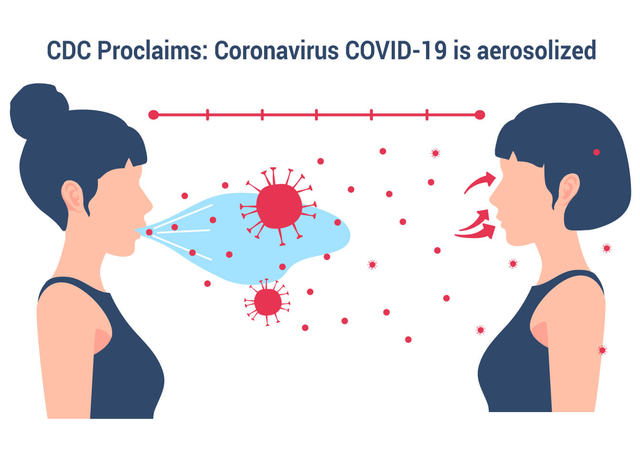Is Coronavirus Aerosolized
But much remains unknown about whether the aerosolized virus is. Health officials say COVID-19 spreads by three main ways.

Aerosol Transmission Of Sars Cov 2 By Children And Adults During The Covid 19 Pandemic Moschovis 2021 Pediatric Pulmonology Wiley Online Library
Studies that suggest that COVID-19 can become aerosolized include one from the New England Journal of Medicine that got a lot of attention.

Is coronavirus aerosolized. New model reveals the aerosolized particles carrying the coronavirus can remain in the air longer than was previously suggested. If a healthcare facility or setting can demonstrate that the generated aerosol is effectively captured or disinfected to prevent. Having these small droplets and particles that contain virus land on the eyes nose or mouth especially through splashes and sprays like a cough or sneeze.
The most common types of viruses causing infections in the respiratory tract through aerosol transmission are influenza viruses rhinoviruses coronaviruses respiratory syncytial viruses RSVs and parainfluenza viruses Morawska 2006. When an infected individual emits aerosols they are more likely to spread disease in poorly ventilated indoor spaces. At issue is the constantly shifting interpretation of droplet size with reference to SARS-CoV-2.
However airborne or aerosolized transmission of the virus has been proposed as a source of infection almost since the inception of the COVID pandemic. The novel coronavirus SARS-CoV-2 can survive in the air for several hours in fine particles known as aerosols according to preliminary research. Recent experiments have shown that the SARS-CoV-2 aerosol remains viable in the air with a 1-h half-life.
Outdoors however the virus can disperse more easily. An inactivation of airborne pathogenic Middle East Respiratory Syndrome MERS-CoV virus was investigated under controlled laboratory conditions. Although the levels of the microbe that causes Covid-19 in most rooms were undetectable or low the study did find the presence of the virus in aerosol form.
Splashes and sprays. The SARS-CoV-2 transmission has. The World Health Organization recently admitted that Coronavirus is airborne and has updated its public health guidance with the following statement on how the.
1 representing common office environment. As a result SARS-CoV-2 aerosol and fomite transmission are acceptable because the virus may remain to survive and infectious in the aerosols and on the surfaces for hours and up to days Van Doremalen et al 2020. The coronavirus which causes the respiratory.
As part of their work they created laboratory conditions in which they showed that the virus could become aerosolized and stay. That there would be non-negligible. April 10 2020 Summary.
An expert committee has concluded that the novel coronavirus is aerosolized through talking or exhalation but its not yet clear if the viral particles are viable and emitted in doses sufficient. These data suggest that health-care workers should be protected from these potentially infectious aerosols when working in close proximity to patients. During the Coronavirus Disease 2019 COVID-19 Pandemic Healthcare facilities and settings should use engineering and work practice controls to reduce worker exposure to generated aerosols to the extent feasible.
A handful of studies suggest the new coronavirus SARS-CoV-2 can exist as an aerosol in health care settings. This can happen when an infectious person coughs or sneezes for example. COVID-19 is spread in three main ways.
Breathing in small virus-containing droplets and particles that have been exhaled by an infected person. These PPEs have been in short supply in the US during early phases of the COVID-19 pandemic which is increasing the risk faced by health care workers HCWs who are treating patients using aerosolized medications. 3 hours agoThe ongoing coronavirus disease 2019 COVID-19 pandemic caused by SARS-CoV-2 has spread across the world infecting about 3 of the global human population.
Traditionally droplets are defined as large 5 microns aqueous bodies. Growing evidence shows that coronavirus can travel in tiny droplets in the air hanging out possibly for hours infecting people who then breathe in that. Researchers looked at how long the virus could survive on various surfaces.
Breathing in air when close to an infected person who is exhaling small droplets and particles that contain the virus. Having these small droplets and particles land on the eyes nose or mouth. Despite taking appropriate precautions HCWs are becoming infected with COVID-19.
New studies hint that the coronavirus may be evolving to become more airborne The virus appears to spread through the air but masks reduce the amount of infectious virus A. Researchers modeled a scenario where an infected person coughs in a supermarket aisle. Two sets of climatic conditions were used in the experiments.
Data are accumulating that severe acute respiratory syndrome coronavirus 2 SARS-CoV-2 the virus that causes COVID-19 is transmitted by both small and large particle aerosols. The weight of the evidence suggests that the new coronavirus can exist as an aerosol a physics term meaning a liquid or solid the virus suspended in a gas like air only under very limited. Aerosolized particles of SARS-CoV-2 the virus that causes COVID-19 can linger in the air for hours after people cough sneeze talk or sing research shows By Shanley Pierce July 23 2020 Can the coronavirus spread through the air.

Aerosol Transmission Of Sars Cov 2 Evidence Prevention And Control Sciencedirect

A Mathematical Framework For Estimating Risk Of Airborne Transmission Of Covid 19 With Application To Face Mask Use And Social Distancing Physics Of Fluids Vol 32 No 10

Cdc Proclaims Coronavirus Covid 19 Is Aerosolized Aeramax Professional

Modelling Aerosol Transport And Virus Exposure With Numerical Simulations In Relation To Sars Cov 2 Transmission By Inhalation Indoors Sciencedirect
Posting Komentar untuk "Is Coronavirus Aerosolized"